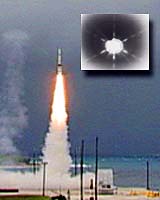| . |  |
. |
|
By Jim Garamone  Washington - January 20, 2000 - Preliminary data indicates two infrared sensors aboard the exoatmospheric kill vehicle, an experimental DoD missile, caused the failure of a National Missile Defense test Jan. 18.
Washington - January 20, 2000 - Preliminary data indicates two infrared sensors aboard the exoatmospheric kill vehicle, an experimental DoD missile, caused the failure of a National Missile Defense test Jan. 18.Other guidance systems -- both on the ground and aboard the rocket -- worked well, said a senior military official. The official compared the test to finding a house. "You start off with the satellite sensors telling you the state, the early warning radar telling you the ZIP code, while the [radars aboard the rocket] get you to the street address," said the official. "What we failed to do is ring the doorbell." The official said the infrared sensors guide the kill vehicle in the final seconds of flight. The test -- called integrated flight test 4 -- pitted the experimental national missile defense system against a simulated warhead launched aboard a Minuteman missile from Vandenberg Air Force Base, Calif. The kill vehicle launched from Kwajalein Missile Range in the Pacific. The previous test vaporized the target with a direct hit. The kill vehicle is the bullet of the weapon system. It destroys a target using the kinetic energy of the force of impact; there are no explosives involved. Had the test worked, the kill vehicle and the target would have hit at about 15,000 miles an hour. Officials said that initially everything appeared to go well. One objective of the test was to evaluate the kill vehicle's deployment and orientation. The vehicle launched, deployed and, using visual sensors, oriented it correctly, officials said. "It was in 'the basket,'" said the official. Another goal was to demonstrate the ability of the space-based sensors and ground-based radars to detect and acquire a simulated threat, track the threat and discriminate using the prototype ground-based x-band radar at Kwajalein. This, too, worked well. Finally, the test demonstrated the Battle Management Command and Control and Communication system. This is the nerve center of the system. It receives the information it gathers from the space-based sensors and from radars and then processes it. "Then it sets up the engagement and provides real-time data communications directed to the weapon," said the official. The system's performance was "nominal" -- space talk for it worked well. The test seemed to be a success until the last six seconds. "It appears that there was an anomaly or an issue with the infrared sensor packages," the official said. "This seeker has two infrared sensors and one visual light. We have to go figure out what happened to the IR sensors. "As we're sitting there at 29 minutes, 49 seconds after the target lifted off, there was not the bright flash that we saw on the [previous test, indicating a hit]." The prime contractor for the system is Boeing. Raytheon built the exoatmospheric vehicle, and TRW built the Battle Management Missile Command and Control and Communication system. The test cost about $100 million. Ballistic Missile Defense Organization officials along with the contractors will examine the data from the test and make corrections as needed. The official said DoD can "absolutely" overcome the technical challenges of the program. The next test is set for spring.
|
| |||||||||
| The content herein, unless otherwise known to be public domain, are Copyright 1995-2016 - Space Media Network. All websites are published in Australia and are solely subject to Australian law and governed by Fair Use principals for news reporting and research purposes. AFP, UPI and IANS news wire stories are copyright Agence France-Presse, United Press International and Indo-Asia News Service. ESA news reports are copyright European Space Agency. All NASA sourced material is public domain. Additional copyrights may apply in whole or part to other bona fide parties. Advertising does not imply endorsement, agreement or approval of any opinions, statements or information provided by Space Media Network on any Web page published or hosted by Space Media Network. Privacy Statement All images and articles appearing on Space Media Network have been edited or digitally altered in some way. Any requests to remove copyright material will be acted upon in a timely and appropriate manner. Any attempt to extort money from Space Media Network will be ignored and reported to Australian Law Enforcement Agencies as a potential case of financial fraud involving the use of a telephonic carriage device or postal service. |